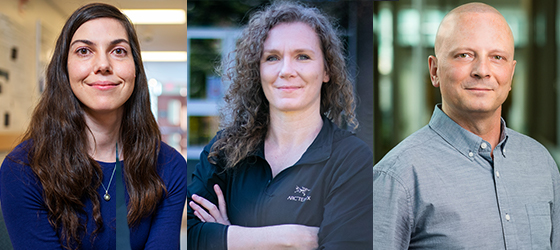Research to understand and treat the adverse effects of COVID-19 on the brain continues with new CIHR grant
Neuroscientists Dr. Leigh Anne Swayne and Dr. Marie-Ève Tremblay (both Division of Medical Sciences) will continue their research on COVID-19 and the brain with a new $293,000 Operating Grant from the Canadian Institutes of Health Research (CIHR) Emerging COVID-19 Research Gaps & Priorities Funding Opportunity.
Some COVID-19 patients develop neurological symptoms that range from acute, very severe outcomes like stroke to more common ones like headache, trouble thinking clearly, anxiety, and depression. Those more common symptoms can last for quite a while after the infection has cleared. While we’re not certain how COVID-19 causes these conditions, Dr. Swayne, Dr. Tremblay, and their colleague, infectious disease expert Dr. Darwyn Kobasa (National Microbiology Laboratory) have a theory: inflammation.
“These neurological symptoms are consistent with those seen when the body mounts a defense against an infection in a process called inflammation,” says Swayne. “The body releases factors into the bloodstream called inflammatory mediators, and these can make their way into the brain.”

Once in the brain, these mediators can trigger the brain’s immune and glial cells to become “reactive.” In their reactive state, immune and glial cells (which include microglia) can dismantle and destroy neuronal connections, along with the blood-brain barrier, which can result in impaired decision-making, cognitive decline, and anxiety and depression.
“Microglia are the resident immune cells of the brain” says Tremblay. “They are normally beneficial cells, notably involved in learning and memory, as well as in the adaptation to the environment, but they can become detrimental upon exposure to various challenges, including viral infection, which compromise their roles.”
Using samples from two experimental models of COVID-19 infection established in Dr. Kobasa’s lab, Dr. Swayne’s team will use confocal and super-resolution fluorescence microscopy to study population-level changes in microglia, as well as in another type of glial cell called astrocytes, whose properties and function are also affected by inflammation. Additionally, her group will investigate how COVID-19 impacts the interactions of these glial cells with the communicating cells of the brain, called neurons, and the structural integrity of connections between neurons, a growing area of expertise in the lab. They will also use biochemical approaches to measure the levels of inflammatory mediators in the brain.
Dr. Tremblay and her team will use cutting-edge electron microscopy with 3D-reconstructions to study changes in microglial interactions with neuronal connections and the vasculature, which is a key expertise of the lab. A special subset of stressed microglia discovered by the Tremblay lab and found to be associated with different pathological states including depression and neurodegenerative diseases will also be examined for the first time in the COVID-19-affected brain.
Drs. Swayne and Tremblay will compare these brain outcomes with analyses of lung histopathology and systemic immune and inflammatory responses performed by Dr. Kobasa’s group.
Along with testing their theory that inflammation in the body associated with COVID-19 leads to changes in the brain, the research team will also test the ability of a drug that might block or reverse these changes. The drug in question targets a protein called pannexin 1, a protein that the Swayne lab previously showed (here and here) to regulate neuronal connectionsimmune and glial cell responses.
The drug is also already approved for use in humans, meaning this research could directly lead to clinical trials or new approval to treat neurological symptoms in COVID-19 patients or in those recovering from COVID-19.
“To do this work, we will use our skillset in microscopy and biochemistry, as well as capitalize on our expertise in the biology of neuroinflammation, immune and glial cell biology, pannexin 1 blockers, and neuronal connections,” says Dr. Swayne. “The outcomes of this work will provide new understanding of brain changes resulting from COVID-19, which will help with diagnosis and treatment strategies.”
Earlier this year, Dr. Swayne and Dr. Tremblay (with Dr. Kobasa as a collaborator) received $30,000 from the first University of Victoria Research Accelerator Fund (RAF) campaign for this research.
